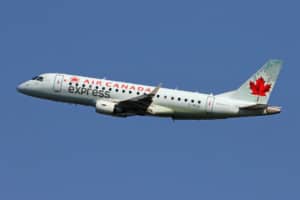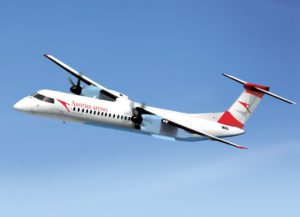In the world of aviation, De Havilland Dash 8 and Embraer E-Jet family aircraft have been major contenders in the regional airline industry for some time. In this blog post, we’ll be pitting two popular ERJ 175 vs Q400 aircraft models to find the winner.
| Aircraft: | Embraer 175 | Bombardier Q400 |
|---|---|---|
| Photo: |
 |
 |
| Country: | Brazil | Canada |
| Manufactured: | from: 2004 to: Present | from: 1983 to: Present |
| ICAO: | E175 | - |
| Price: | $45.7 million | $32.2 million |
| Avionics: | Honeywell Primus Epic | Rockwell Collins Pro Line Fusion |
| Engine: | 2x 2 X General Electrics CF34-8E | 2 X Pratt and Whitney PW150A |
| Engine Type: | Turbofan | - |
| Power: | 14,200 pound-force | 5,071 horsepower |
| Max Cruise Speed: |
480 knots 889 Km/h |
360 knots 667 Km/h |
| Approach Speed (Vref): | - | - |
| Travel Range: |
2,200 Nautical Miles
4,074 Kilometers |
1,362 Nautical Miles
2,522 Kilometers |
| Fuel Economy: |
0.65 nautical mile / gallon 0.318 kilometres / litre |
0.8 nautical mile / gallon 0.391 kilometres / litre |
| Service Ceiling: | 41,000 feet | 25,000 feet |
| Rate of Climb: |
2000 feet / minute 10.16metre / second |
- |
| Take Off Distance: |
2244 metre 7,362.12 feet |
1402 metre 4,599.68 feet |
| Landing Distance: |
1261 metre 4,137.09 feet |
1287 metre 4,222.39 feet |
| Max Take Off Weight: |
40,370 Kg 89,000 lbs |
142,196 Kg 313,485 lbs |
| Max Landing Weight: | - | - |
| Max Payload: |
10,094 Kg 22,253 lbs |
8,669 Kg 19,112 lbs |
| Fuel Tank Capacity: |
3,072 gallon 11,629 litre |
1,697 gallon 6,424 litre |
| Baggage Volume: |
9.2 m3 325 ft3 |
14.2 m3 501 ft3 |
| Seats - Economy: | 88 seats | 78 seats |
| Seats - Business Class: | 86 seats | 68 seats |
| Seats - First Class: | - | - |
| Cabin Height: |
2 metre 6.56 feet |
1.95 metre 6.40 feet |
| Cabin Width: |
2.74 metre 8.99 feet |
2.51 metre 8.23 feet |
| Cabin Length: |
21.2 metre 69.55 feet |
18.8 metre 61.68 feet |
| Exterior Length: |
31.68 metre 103.94 feet |
32.84 metre 107.74 feet |
| Tail Height: | 9.86 metre - 32.35 feet | - |
| Fuselage Diameter: |
3.01 metre 9.88 feet |
2.69 metre 8.83 feet |
| Wing Span / Rotor Diameter: |
26 metre 85.30 feet |
28.42 metre 93.24 feet |
| Wing Tips: | Blended Tips | No Winglets |
| More Info: | Embraer 175 | Bombardier Q400 |
|
Data presented is for entertainment purposes and should not be used operationally.
|
About the E175
The Embraer E175 is a twin-engine commercial jet that was first introduced in 2006. It’s part of Embraer’s family of “E-Jets,” which also includes the smaller E170 and the larger E190. To date, there have been nearly 450 E175s delivered to airlines around the world.
Why was it developed and built?
The E175 made its maiden flight in July 2005 and entered commercial service with US Airways. It has become famous for short- and medium-haul routes thanks to its fuel efficiency and low operating costs. Plus, it’s flown by major airlines such as United Airlines, American Airlines, and Delta Air Lines.
What purpose does it serve?
The E175 can seat up to 78 passengers in a two-class cabin configuration or 88 in a single-class configuration. It has a range of 4,074 nautical miles (2,200 kilometers) and a top speed of 541 miles per hour (871 kilometers per hour).
It offers good fuel efficiency and low operating costs, making it a popular choice for short- and medium-haul routes. While it’s had two serious incidents in its history, both flights were able to make emergency landings without injury to any passengers or crew.
About the Q400
The Q400 is a twin-engine turboprop plane manufactured by the Canadian company Bombardier. It is often used for short-haul flights, as it can take off and land on smaller airports with shorter runways.
Why was it developed and built?
The Q400 was designed to provide a cost-effective alternative to larger jet aircraft with the same performance and passenger capacity. It entered service with Scandinavian Airlines System (SAS) in February 2000.
What purpose does it serve?
The Q400 is a twin-engine turboprop passenger plane. It made its maiden voyage in 2000 and entered commercial service later that year. The Q400 is larger, faster, and more fuel-efficient than its predecessor.
It is used primarily for short-haul flights; however, it is also capable of flying routes of up to 1,100 miles. This versatile plane is used by airlines worldwide!
How are the E175 and Q400 different?
There are many factors to consider, such as seat count, range, fuel efficiency, and operating costs. Let’s take a closer look at two popular aircraft models—the E175 and the Q400—and compare their features side by side.
Seat Count
The E175 has a typical seating configuration of 88 seats, while the Q400 can seat up to 90 passengers. For airlines that regularly operate at or near capacity, the additional seats offered by the Q400 could make a significant difference in revenues.
Range
The E175 has a range of 4,074 kilometers, while the Q400’s range is slightly shorter at 2,040 kilometers. The additional range offered by the E175 could be important for airlines that regularly operate long-haul flights.
Fuel Efficiency
The E175 is more fuel efficient than the Q400, with a max fuel capacity of 9,335 kg compared to the Q400’s 1724 gallons. For airlines looking to reduce their operating costs, the E175 could be the better option.
Size
The most significant difference is in their size; the E175 is a much larger aircraft than the Q400. The E175 has a wingspan of 26.01 meters, while the Q400 has a wingspan of just under 28.4 meters.
The length of the E175 is also nearly 1.13 meters longer than the Q400. This difference in size affects both the range and fuel efficiency of the two aircraft; because it is larger, the E175 can fly further on less fuel than the Q400.
Speed
Another difference between these two aircraft is their speed; the E175 can cruise up to 871 kilometers per hour, while the Q400 maxes out at 667 kilometers per hour.
How are the E175 and Q400 similar?
Here is a breakdown of the key similarities between the E175 and the Q400.
- Both the Embraer E175 and the Bombardier Q400 are single-aisle aircraft with a capacity of around 80 passengers.
- They are both turboprop aircraft, meaning they have propellers powered by turbine engines.
- The E175 and the Q400 have a range of around 2,500 miles. And finally, both planes are used primarily for regional flights.
What’s better about the E175?
If you’re looking for the best flying experience possible, E175 is excellent.
- The E175 is more fuel-efficient than any of our previous models. It can fly up to 12,000 nautical miles on a single tank of gas, making it perfect for long-haul flights.
- The E175 is also incredibly quiet. It has advanced sound-dampening technology, making it one of the quietest aircraft in its class.
- Finally, the E175 is very comfortable. It has wider seats than our other models, so you’ll have plenty of room to stretch out and relax on your flight.
The enhanced cabin lighting and larger windows create a bright, airy atmosphere that makes you feel at home in the sky.
What’s better about the Q400?
The Q400 is a high-performance turboprop aircraft that offers significant advantages over its predecessors. It is quieter, faster, and more efficient, making it the perfect choice for regional airlines.
The Q400 can seat up to 78 passengers and has a range of 2,530 miles. It is powered by two General Electric CT7-8F5 engines, which give it a top speed of 400 mph.
The Q400 can also take off and land on shorter runways than other turboprop aircraft, making it ideal for airports with limited space.
In addition, the Q400 has one of the lowest operating costs in its class, making it an attractive option for budget-conscious airlines. Thanks to its combination of performance and value, the Q400 is among the best-selling turboprop aircraft in the world.
Conclusion
The Embraer 175 and the Bombardier Q400 are single-aisle aircraft with similar ranges and seating capacities. However, several differences make one or the other a better choice in certain situations.
The E175 is more fuel-efficient and quieter than the Q400, making it the best choice for long-haul flights. And Q400 is faster and more efficient, making it the perfect option for regional airlines.
Ultimately, the decision of which aircraft to use depends on the specific needs of your airline.


